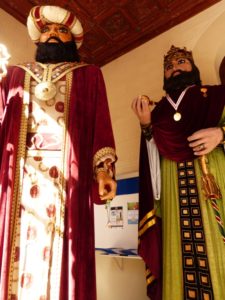

Photo by Claudio Cervello via Visualhunt
The feast of Corpus Christi is a Christian celebration that takes place two months after Maundy Thursday, on the eleventh day after Pentecost. It is celebrated in Barcelona in a very peculiar way, and it is one of the most historic festivities in Barcelona. Today, this article by ShBarcelona will tell you more about the fun event of the Feast of Corpus Christi, that you can enjoy on June 20, 2019 in the streets of the Gothic district of the Catalan capital.
Related article: Enjoy San Juan 2019 in Barcelona


Photo by calafellvalo via Visualhunt
The feast of Corpus Christi, considered a true festivity in Barcelona for centuries, is a tradition that has more than six hundred years of history in the city. On this day the most representative cultural figures of the Catalan capital will be represented in a procession. In addition, this way of celebrating became a model years ago for many other towns in the country. The Corpus Christi procession is a religious, festive and popular activity during this holiday. It is divided into two parts: the more playful procession organized by the city’s town hall, in which historical figures from the imagery of Barcelona are accompanied by music groups and traditional dances; and the mythical procession, organized by the Chapter of the Cathedral. For a certain period of time before the feast takes place, the festive imagery is exhibited in the Town Hall, located at Plaça de Sant Jaume. That following Sunday, at seven o’clock in the afternoon and while the Archbishop of Barcelona officiates the Mass of Corpus Christi in Pla de la Seu, the festive procession moves from Plaça de Sant Jaume to the Cathedral, along Bisbe Street.
Related article: Tree Pollen Allergies in Barcelona
Photo by Javier Garcia Canals via Visualhunt
There are more manifestations on this popular day, such as L’ou com balla (or the dancing egg in English), which are scheduled during the feast of Corpus Christi. L’ou com balla has been a tradition – only in Barcelona – since 1440. And it has now become an attractive sight to see. It takes place in the cloister of the Cathedral and its influence has spread to other places in Barcelona and nearby towns. It is an event that consists of making an empty egg “dance” on the water jet of a cloister spring fountain, but you can also find it in some other squares, gardens of institutions or at some private gardens. The water jet the egg dances on, is caught by a reservoir, that is decorated with flowers and cherries. This specific practice has an unknown origin and can be interpreted in different ways. Apparently it was born as a form of entertainment between the bourgeoisie and the upper class, to kill time before the procession passed. But that is just one of the explanations to be considered, other options are: to honour spring and fertility, represented by the jet of water or the egg itself, or another reason why this curious ritual was initially performed, could be the symbol of the chalice used during the Eucharist, which would be the reservoir that surrounds the water jet.
*Main Photo by Claudio Cervello via Visualhunt
Have you seen the egg dance on the water? What did you think?
Maybe you're thinking about selling a property or you've just inherited one or more real…
Do you enjoy strolling among trees and plants, away from the hustle and bustle of…
If you are planning to move to Barcelona for a few months or permanently, one…
ShBarcelona establishes itself as the leading agency within the Apialia Eixample Group, reaffirming its position…
Are you going to visit Barcelona this 2025? The vibrant Catalan capital once again becomes…
In long-term rentals, a common issue is poor boiler maintenance, which can lead to unexpected…